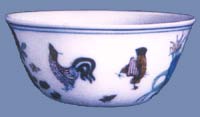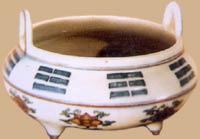|
"Dou cai" porcelain
"Dou cai" (plan with colors) is one of the traditional decorating technologies of ceramics. Because underglaze blue and white color, on-glaze color and antique color were combined for decorating, so it was called "dou cai". They could be classified into four categories: stippling decoration, overlapping color, dyeing decoration and filling decoration of blue and white ceramics.
"Dou cai" initiated from the reign of Xuande of the Ming Dynasty. Underglaze blue and famille verte bowl with mandarin duck in lotus pond found in Sajia Monastery of Tibet in 1985 was inscribed with six Chinese Early dou cai porcelain is pretty beautiful, and decorated range is not very wide. However, after the reign of Jiajing and Wanli, it became dense, rich and gaudy. Dou cai in the reign of Kangxi, Yongzhen and Qianlong of the Qing Dynasty inherits and develops the dou cai of the Ming Dynasty.
Dou cai chicken cup
 Made in the Ming Dynasty, 3.3cm in height, 8.3cm in diameter and 4.1cm in foot diameter, this piece is now collected in the Beijing Forbidden City Museum. It is shallow, and has left-falling mouth and lying foot. The internal part is white glazed but not decorated. The exterior part is decorated with 4 groups of dou cai designs. One is orchid and pillar stones, one is peony and pillar stone. The rest two groups are 5 hens and chickens. The design is bright-colored; the skill for painting is fine, vivid and lifelike. The internal part of foot is inscribed with 6 Chinese characters, which mean it was made in the reign of Chenhua of the Ming Dynasty. Made in the Ming Dynasty, 3.3cm in height, 8.3cm in diameter and 4.1cm in foot diameter, this piece is now collected in the Beijing Forbidden City Museum. It is shallow, and has left-falling mouth and lying foot. The internal part is white glazed but not decorated. The exterior part is decorated with 4 groups of dou cai designs. One is orchid and pillar stones, one is peony and pillar stone. The rest two groups are 5 hens and chickens. The design is bright-colored; the skill for painting is fine, vivid and lifelike. The internal part of foot is inscribed with 6 Chinese characters, which mean it was made in the reign of Chenhua of the Ming Dynasty.
Dou cai covered jar with fish and algae design

Made in Jingdezhen Kiln in the Qing Dynasty, 22.1cm in height, 6.4cm in diameter and 6cm in bottom diameter, this piece is now collected in Shanghai Museum. It has straight mouth, short neck, ring foot and pearl-shaped lid. The lower part of its abdomen and the surface of lid are decorated with fish and algae design. Both are painted contours by using blue and white color, filled with red, green, purple and black color. The color is bright and lustrous. The exterior part of bottom is inscribed with 6 celadon glazed Chinese characters in regular script, which means it is made in the reign of Kangxi (1662-1722) of the Qing dynasty.
Dou cai oven with the Eight-Diagrams design
 Made in Jingdezhen kiln in the Ming Dynasty, 9.8cm in height, 12.1cm in caliber and 7.5cm in foot diameter, this piece is unearthed in the Qing tombs of Beijing in 1962, and collected in the Capital Museum of China. The mould is close to the pattern of Xuande copper oven. It has oblate belly, large mouth slightly inverted, semi-circle-shaped standing ears. The base is pure white, while the glaze is bright and lustrous. There are celadon designs of the Eight-Diagrams painted on the upper part of its belly and 8 purple red dou cai broken branches of flowers on the lower part. The bottom is inscribed with six Chinese characters in regular script, which means it is made in the reign of Jiajing of the Ming Dynasty. Made in Jingdezhen kiln in the Ming Dynasty, 9.8cm in height, 12.1cm in caliber and 7.5cm in foot diameter, this piece is unearthed in the Qing tombs of Beijing in 1962, and collected in the Capital Museum of China. The mould is close to the pattern of Xuande copper oven. It has oblate belly, large mouth slightly inverted, semi-circle-shaped standing ears. The base is pure white, while the glaze is bright and lustrous. There are celadon designs of the Eight-Diagrams painted on the upper part of its belly and 8 purple red dou cai broken branches of flowers on the lower part. The bottom is inscribed with six Chinese characters in regular script, which means it is made in the reign of Jiajing of the Ming Dynasty.
Simple and pure Cizhou Ware
Color enamels porcelain
|

